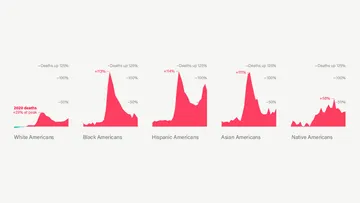It seemed a welcome announcement for prisoners and their families. On Thursday, U.S. Attorney General William Barr ordered the federal prison system to release some elderly or sick people instead of keeping them in overcrowded penitentiaries where the coronavirus is already spreading.
There are “at-risk inmates who are non-violent and pose minimal likelihood of recidivism and who might be safer serving their sentences in home confinement,” Barr wrote in a two-page memo to the Bureau of Prisons.
But on closer inspection, his plan may exclude many vulnerable prisoners from being released—and may also create racial disparities in who gets out of prison.
That’s because it instructs the prison system to prioritize for release only those prisoners who receive the minimum possible score on a “risk assessment” algorithm called PATTERN. This computerized rating system, which has never been used before, deems white-collar offenders, who are disproportionately white, generally safe to be let out of prison. But it does not deem safe to release drug addicts with a history of prior arrests, who are disproportionately black due in part to the biased policing practices of the War on Drugs.
Only 7 percent of black men in federal prisons would be considered low-risk enough to get out using PATTERN—compared with 30 percent of white men, according to an internal assessment conducted by the Justice Department last year.
In addition, Barr’s memo blocks anyone convicted of a sex offense or violent crime from being released to home confinement. Justice Department policy also bars all non-citizens convicted of immigration-related offenses from serving out their time at home.
The Justice Department did not respond Friday to a request for comment.
To be sure, Barr’s action could result in as many as hundreds of people being released from prison within weeks. And most states and local jurisdictions that have begun to release some incarcerated people as the pandemic has spread have also focused their efforts on non-violent offenders.
But some prisoner advocates lamented that Barr’s directive was not more expansive.
“The Trump administration keeps touting its commitment to criminal justice reform, but its attorney general is not using his discretion in any way to ensure the health and safety of people in the system—including prison guards, who are also at risk due to overcrowding,” said Sakira Cook, director of the Justice Reform Program at The Leadership Conference on Civil and Human Rights.
Barr’s memo comes as criminal justice reform advocates around the nation call for the release of large numbers of incarcerated people who are elderly or sick, who are close to finishing their sentences or who are serving time on minor charges, such as parole or probation violations. Prisons and jails, these advocates say, are likely to become breeding grounds for the coronavirus given their cramped quarters, lack of sanitation products and often poor medical care.
Meanwhile, a bipartisan group of lawmakers on Capitol Hill had hoped to include in the $2 trillion stimulus package signed by President Trump on Friday some funding to incentivize states to release prisoners vulnerable to the disease. Republican leaders in the Senate blocked that effort, according to several congressional aides and advocates. Instead, the bill includes smaller grants to police departments and jails nationwide, to be used as those localities see fit rather than explicitly aimed at letting people out of crowded facilities where social distancing is impossible.
The PATTERN risk-assessment algorithm was originally created as part of the First Step Act, which President Trump signed into law in late 2018 in part to reduce the federal prison population. The algorithm has not been fully tested or independently reviewed prior to this use of it amid the pandemic, according to the National Institute of Justice, a research wing of the Justice Department.
Risk-assessment algorithms are computerized versions of the appraisals that judges make every day: considering a person’s criminal history and demographics to score them on their likelihood of committing another crime. But these mathematical tools have faced criticism for giving the appearance of being colorblind—it is a computer making the decisions about whom to release, after all—while in fact exacerbating racial disparities.
“There’s racial bias inherent at every step of the criminal justice system, from policing to prosecution to sentencing, so an algorithm that uses those things to determine whether to release you is not going to be fair to people of color,” said Kara Gotsch, director of strategic initiatives for The Sentencing Project.
Gotsch said the Justice Department should be looking at the entirety of a person’s life circumstances: their age, health and susceptibility to the virus, their good conduct while in prison, and how long they have already been serving time. Some of these factors are mentioned in the attorney general’s memo, but they would be overruled by a bad score on the PATTERN assessment.
Barr said in his memo that the new release policy would keep prisoners and staff safe from “the pandemic currently sweeping across the globe.”
He wrote that when making its decisions about whom to release, the Bureau of Prisons should also consider whether the inmate has ever engaged in gang-related activity, whether the inmate has demonstrated a verifiable plan for where he or she will go once released, and whether that plan may actually increase the inmate’s likelihood of contracting the coronavirus, among other factors.
“While we have an obligation to protect B.O.P. personnel and the people in B.O.P. custody, we also have an obligation to protect the public,” Barr wrote, explaining why he would not release anyone who did not meet these criteria.
To that end, he also ordered that anyone selected for release to home confinement must first serve 14 days in quarantine before getting out of prison. Prisoner advocates say they fear that will simply mean solitary confinement.
